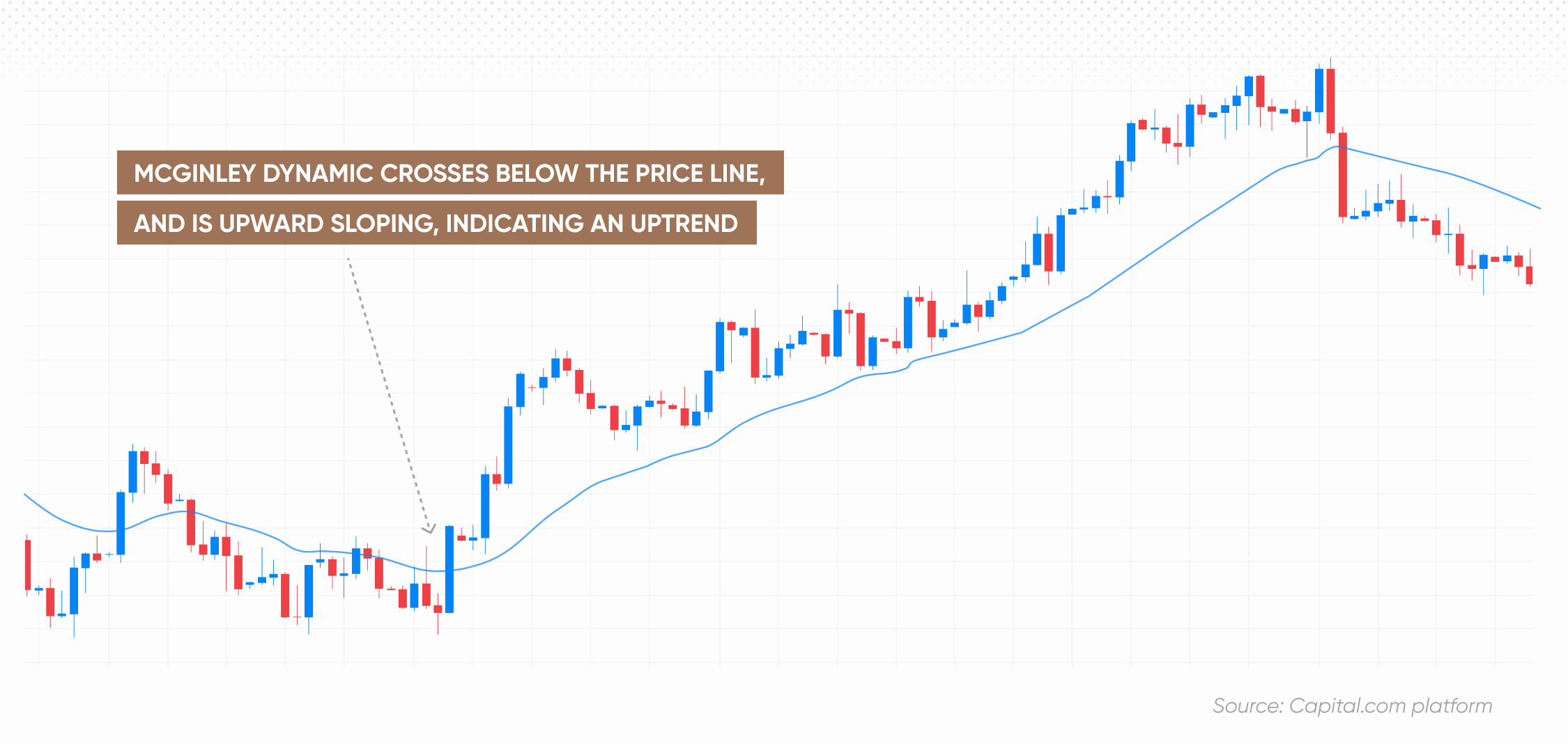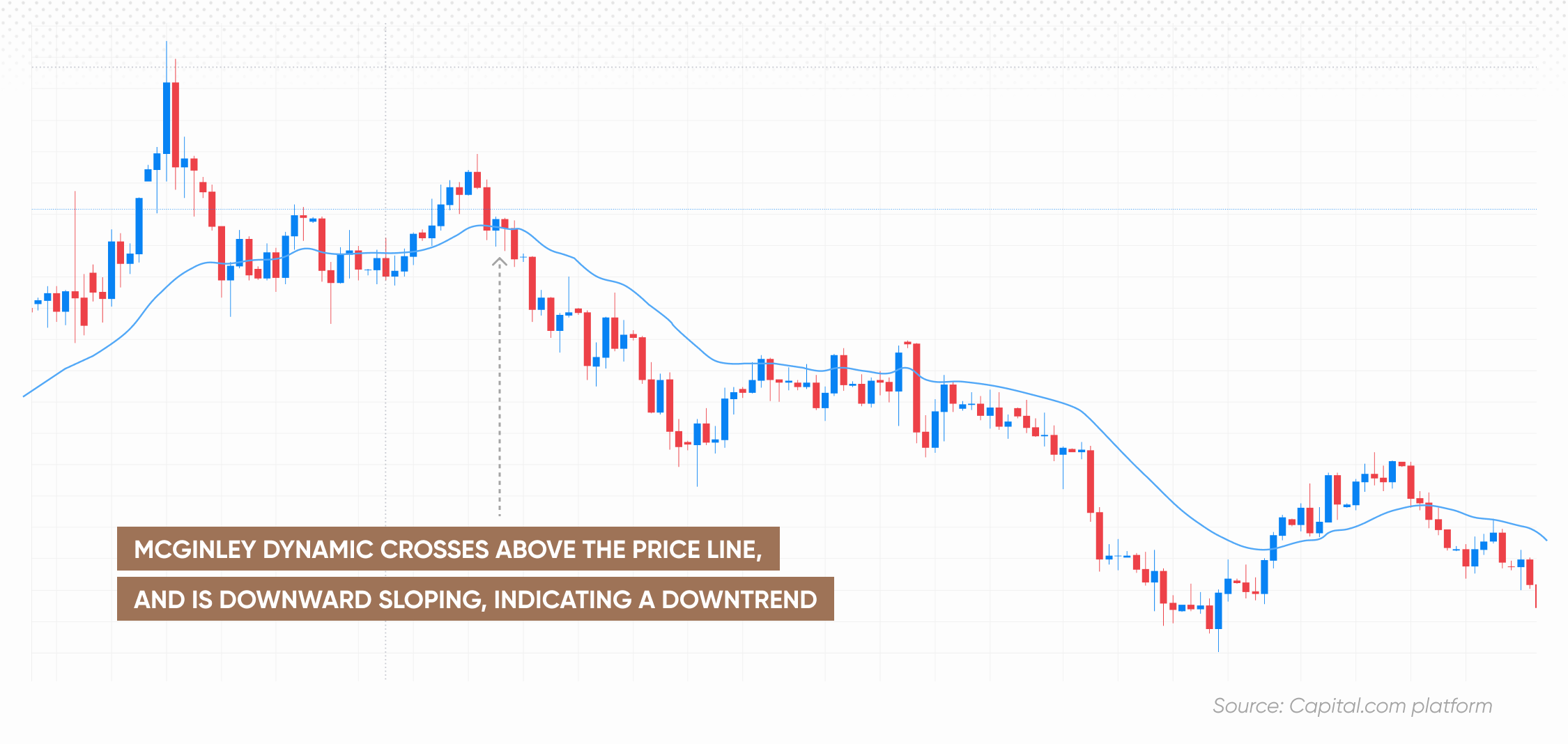How to trade using the McGinley dynamic indicator

What is the McGinley dynamic indicator?
The McGinley dynamic indicator is a technical analysis tool that aims to solve the lag issue found in traditional moving averages (MA). Invented by John R. McGinley in 1990, it adjusts itself relative to the speed of the market and provides a smoother trend line that minimises price separation. This adaptive moving average is often used by traders to identify market trends and potential signals.
Highlights
-
The McGinley dynamic indicator, developed by John R. McGinley, is a technical tool that minimises the lag issue present in traditional moving averages.
-
Interpretation of the McGinley dynamic is similar to traditional moving averages; a price crossing above the line suggests a potential bullish trend, while a price crossing below may signify a potential bearish trend.
-
Advantages of the McGinley dynamic include responsiveness to price changes, potential in reducing whipsaw trades, and versatility across markets and timeframes.
-
The indicator’s limitations include potential for false signals, reduced effectiveness in range-bound markets, and limited availability on trading platforms.
McGinley dynamic indicator explained
The McGinley dynamic indicator, despite not being as well-known as other technical indicators, has a distinct place in the world of market analysis. It was brought to life by John R. McGinley, a certified market technician and former editor of the Market Technicians Association Journal.
The analyst first introduced his dynamic indicator in an article in the Market Technicians Association Journal published in 1990. His primary goal was to create a tool that would minimise the lag effect inherent in traditional moving averages, a common drawback that often led to misleading signals and late responses to price changes.
McGinley believed the dynamic indicator provided a better reflection of the market than traditional moving averages, by incorporating an adaptive filter, which adjusts sensitivity based on price volatility. Despite its conception over three decades ago, the McGinley dynamic indicator still finds relevance today among traders who value its innovative approach to tracking market trends.
McGinley dynamic indicator formula
The McGinley dynamic indicator relies on a formula that adjusts itself with market speed. At its core, the indicator is a form of moving average, but with a unique adjustment factor that changes with price volatility. Here's a look at how the formula works:
MD = MD1 + (Price – MD1) / (N * (Price/MD1)^4)
Where:
MD1 = the previous value of the McGinley dynamic indicator.
Price = the most recent price in the data series.
N = a smoothing factor chosen by the trader or analyst. It's often set to a default value of 10, but can be adjusted based on individual trading strategies and preferences.
(Price/MD1)^4 = This ratio, raised to the fourth power, acts as an adaptive factor that adjusts based on the speed of price changes.
When it comes to the McGinley dynamic indicator settings, a common choice is to set the period to 10 for short-term strategies, such as day trading. However, the setting can vary based on trading objectives and market conditions. A longer period, such as 14, 20, or even 30, may be more suitable for long-term trading or more volatile markets. It's always crucial to remember that no single setting fits all situations, so adjustments may be necessary to align with the trader's strategy and the specific financial instrument.
How to interpret McGinley dynamic
When designing a McGinley dynamic indicator strategy, one of the first things you'll notice is how closely the indicator tracks the price. This tight adherence is a result of its innovative formula, and can help in smoothing out market noise.
In terms of specific trading signals, the McGinley dynamic behaves similarly to traditional moving averages. When the McGinley dynamic line crosses below the security price and is moving upwards, it’s often interpreted as a potential bullish signal and traders may consider entering a long position.

Past performance is not a reliable indicator of future results
Conversely, when the indicator crosses above the price and is moving downwards, it's viewed as a potential bearish signal, suggesting a potential sell-off and traders may consider a short position.

Past performance is not a reliable indicator of future results
As the McGinley dynamic is particularly adept at avoiding whipsaws, traders can find it potentially more reliable in volatile markets. However, like any other indicator, it should be used in conjunction with other tools and analysis methods to confirm signals and reduce the risk of false signals. Traders must always be mindful of the broader market context and their own risk tolerance when making trading decisions based on the McGinley dynamic.
Why choose McGinley dynamic?
-
Responsiveness: The McGinley dynamic indicator stands out for its quicker response to price changes compared to standard moving averages, thanks to its adaptive smoothing factor.
-
Taming the whipsaws: The McGinley dynamic indicator helps in reducing whipsaw trades as it smooths out price volatility, ensuring that the trader gets an informed reading of the market trend.
-
Versatility: The McGinley dynamic indicator is versatile. It can be applied to any market and any timeframe, making it a handy tool for many traders and investors.
Limitations of McGinley dynamic
-
Limited accuracy: Like any trading tool, the McGinley dynamic indicator isn't infallible. It can generate false signals, leading to potential losses. Traders are advised to use it in conjunction with other indicators and techniques.
-
Less effective in range-bound markets: In a range-bound or sideways market, the MD may not provide useful signals as it's primarily designed for trending markets.
-
Not widely available: The McGinley dynamic indicator isn't as widely known or available on all trading platforms, which can limit its use.
Final thoughts
The McGinley dynamic indicator is a unique and versatile tool in technical analysis that addresses some common challenges found in traditional moving averages. Conceived by John R. McGinley, it is designed to minimise the lagging nature of moving averages by adapting to the market's speed, and attempting to provide a smoother and more accurate trend line. This feature sets it apart and enhances its usability in different markets and timeframes.
However, like all indicators, the McGinley dynamic is not infallible; it has potential limitations, including the risk of false signals and diminished effectiveness in range-bound markets. Furthermore, it may not be widely available on all trading platforms. Therefore, while it offers innovative solutions to specific challenges, it should ideally be used in conjunction with other tools and analysis methods to corroborate its signals and build a robust trading strategy.
Remember, markets are volatile. You should always conduct your own due diligence before trading, and never trade more funds than you can afford to lose. If in doubt, consider using a demo account, which allows you to test a strategy without using real money.
FAQs
What is the significance of the McGinley dynamic indicator in trading?
The McGinley dynamic indicator is significant in trading due to its adaptive nature that reduces lag and provides a smoother trend line, compared to traditional moving averages. It's particularly useful in volatile markets, helping to minimise false signals or whipsaws.
How to use the McGinley dynamic Indicator?
You can use the McGinley dynamic indicator like a traditional moving average. Potentially bullish signals are typically identified when price crosses above the indicator line, and potentially bearish signals when it crosses below. However, always consider other market factors and indicators before making trading decisions.
How does the McGinley dynamic Indicator compare to other popular technical indicators?
The McGinley dynamic indicator compares favourably with its unique approach to adjusting sensitivity based on price volatility. However, like any other indicator, it's not infallible and should be used in conjunction with other technical analysis tools to help optimise results.